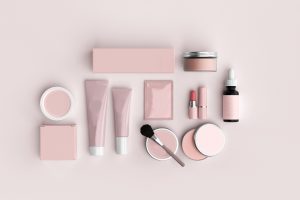Written by: Srimati Roy
About the author: Former Head of Marketing, Viacom 18 Studios

On visits to South Asian countries through the noughties, I had seen masks being used as a barrier against pollutants and a filter against airborne allergens. From simple scarves to intricate gas masks, face coverings were just everywhere.
Back in grimy Mumbai, I too, adopted what seemed like OCD behaviour and benefitted from covering my nose and mouth with cloth wraps during long commutes. I got used to the stares and wondered how much persuasion it would take before masks became commonplace.
Then COVID hit.
Video Calls Go Viral, Self Care Sees A Revival
Across races, ethnicities and faiths, human beings were forced to embrace face coverings.
In tandem, touch-feel went out of people’s lives.
Hands – who knows where they had been? – became a handful with 20-second scrubs replacing quick rinses.
Tectonic shifts happened in the beauty consumer’s behaviour.
With sunglasses on, very little facial real estate would now be visible in public. Lipsticks went out, face fuzz was in.
As reasons-to-buy diminished basis tightened wallets, reduced out-of-home occasions, sharp drops in units per use and altered consumption patterns, the personal care category had to look within and re-invent.
The category is notorious for relentless seasons of campaigning through high decibel advertising. Influencing behaviour change and moving the needle on steadfast consumer preferences has typically been a part of long term objectives. However, in 2020, beauty manufacturers responded almost overnight with great novelty to outshout the novel corona virus.
Hygiene and wellness became star categories in personal care. New entrants topped shopping lists. Hand creams became ubiquitous as fairness creams became “So 2019!” – and immunity-boosting became the must-have functionality across personal care products.
Thus compelling a new generation of video callers – boomers who became zoomers – to adopt instinctive self-care rituals in just one year.
In just one year we upskilled to photo-ready our hair and faces and re-started spending our lipstick monies.
In India, the beauty business is understood to have posted +25% profitability (EBIT) in a year that ought to have sunk its fortunes (Source: The Connected Consumer – Google, Kantar, WPP Report – Nov 2020)
How did the spirited beauty and personal care industries achieve this feat?
Beauty Is As Beauty Does
Beauty is a high profitability business. Beating even homecare categories among CPG businesses. In 2020, it became a high purpose business.
In India alone, the business of beauty (comprising 4 key segments – Skin Care, Hair Care, Makeup and Personal Wash) is growing at a super-fast clip – a revenue finish line of INR 73K Cr in 2019 projected to touch INR 111K Cr by 2024 (Source: Euromonitor).
Even pre-COVID, globally the industry was bracing for an accelerated new decade with step changes in the marketing landscape. A millennial workforce, the rise of e-commerce and changing narratives had seeded in early pivot points predicated on inclusivity, sustainability and trust-ability. ‘Stay At Home’ mandates provided never-before, moonshot opportunities and catalysed this process and earned first movers massive halo effect.
Remember how Lifebuoy issued a PSA print ad way back in January 2020 exhorting consumers to simply wash hands with soap? That is, with or without, Lifebuoy?
Beauty companies were quick to upend production lines to manufacture hand sanitizers and other alcohol-based hygiene products. At one point ITC’s personal care products division averaged a launch of a new COVID-care product every 15 days.
Leading players rushed to protect procurement hubs and supply chains across the world as harvest sources of ingredients such as Shea Butter quarantined.
While the idea of ‘in it together’ intensified, corporates showed that they took care of their value chains. L’Occitane manufactured over 75,000 Litres of hand sanitizers and distributed to health care workers across Europe as gifts.
Globally, a number of bath and body brands installed handwash units with foot-pedalled faucets in their premium outlets to promote hand hygiene in a high-contact environment.
Segueing with the rise of conscious consumption the segment saw a ton of new launches taking off from the higher callings of ‘slow beauty’, ‘clean beauty’ and even ‘blue beauty’ (Products which use less or no water – the most important ingredient for this category). In 2019 itself, L’Oreal had achieved a 60% reduction in water consumption per finished product and has committed to 100% switch to compostable or re-usable packaging by 2025.
There were lessons galore to be learned from beauty brands on thought leadership in a crisis.
Testing, Trying Times
Did you cut your own hair and groom your own eyebrows last year?
Great, you brought the salon home. ‘At home’ solutions were at an all-time high in 2020. But how do you swatch shades at home before you give in to the impulse of purchasing a new colour cosmetic?
A big weapon in any cosmetic marketer’s arsenal is Testers. Trying triggers buying, ergo – makeup makers build the considerable cost of producing, replenishing and phasing out – testers into their marketing/promotion budgets.
Testers are sampled ad nauseum. Many players promote multiple uses of testers with single-use applicators. In the pre-COVID era, lipstick testers would be swabbed using single-use lip brushes, eye products would be tested using q-tips. A clear no-no in post-COVID reality.
Hence tester bars of colour cosmetics shut down completely in the last one year.
Enter the Virtual Try-On.
With sophisticated facial recognition technologies, luxury brands, for example, have pivoted to the point where shade-fits can be tested digitally.
Estee Lauder reported a conversion rate of 2.5X and an upswing of +32% in their virtual try-on range for makeup.
As for salons, by mid-2020, Lakme Salon for example had rolled out exhaustive SOPs including re-training personnel to deliver even contactless eyebrow threading.
Problem-solving did not come easy but businesses passed with flying colours.
Keep Calm And Digitalise
As the beauty shopping experience goes DIY- and the in-store experience moves online – could this signal the exit of our friendly, neighbourhood Beauty Advisor?
The internet kicked in in a big way to deliver the consideration and comparison phases of a beauty buyer’s journey. Brand and e-commerce websites replaced the department store while beauty creators flooded social platforms with DIY content that helped hapless consumers gain oodles of aatmanirbhartaa. Google noted record interest last year in higher-order technologies – 67% of beauty consumers expressed curiosity about virtual reality, 64% inclined towards augmented reality and 69% keen on using voice assistants.
To win, forerunners experimented with multiple formats of content, changed distribution models to D2C via amped up websites, incentivised with free shipping and galvanised gender-neutral purchase behaviour.
Both men and women bought an average of 3 hair care products per month. Does that read like a no brainer? Dive into skincare (including personal wash) we find both men and women buying an average of 6 products per month.
Doorstep delivery has also simplified distribution woes. In fact, Tier 1 (10-40 Lakh population) towns jostled side by side with metros to contribute to search and discovery platforms on the internet, and regional language content creators rose to the fore with Hindi becoming the second most used language worldwide to run searches on Google.
Science Of Things To Come
For an industry that thrives on innovation, leveraging cutting edge beauty tech, and pure scientific research is no longer the next big thing. It is here. YSL just launched the beta version of Perso, a device that makes it possible to create fresh shades and pigments anytime, anywhere, by anybody.
An AI-powered pod gadget, the size of a coffee cup, Perso is loaded with 4 colour cartridges and a patented motorised system to blend and dispense personalised ‘bespoke’ formulas based on real-time data and trend analysis!
Make your own on-demand lipsticks, foundations, and yes, even skincare formulas – enabling consumers to blend infinite permutations of tones and undertones using the accompanying YSL Rouge Sur Mesure app. It lets you store your ‘favourites’, go ‘social’ or get ‘expert’ recommendations – just make sure you don’t run out of charge on-the-go!
Advanced science is also leading the next wave of innovations based on rightsizing regimes and rituals to simplify home care. With hyper-personalisation trending as much as hyper-local, expect to hear terms like skip care, skinimalism, skin fasting, microbiomes and autophagy in advertising very soon.
Because You Are Worth It
To view through the lens of beauty marketers who demonstrated twenty twenty foresight, let consumers feel ‘seen’.
Expect them to be more demanding, more knowledge-thirsty, more diverse, more frivolous, more curious, more conscientious, more questioning, more self-loving but…more anxious and less together than ever before.
Delight them not just with new launches, but with a too-good-to-be-true value system of right doing, right thinking. And impossibly high standards of conducting business.
Not fast benefits from trend cycles, but slow coaching on lifetime benefits. With well-defined products that are ‘not meant for everybody’. Enriched with sensorials that offer moments of calm in a VUCA world.
Be authentic with rational information on ingredients and be especially sharp about education on active ones.
Package in ways that are non-threatening to the planet.
Promote with transparency. About the difference between ‘organic’ and ‘natural’, for example. Or, what exactly is vegan? Or cruelty-free? What even does the neologism ‘free-from’ mean?
Position this as an essential ally in your unique consumer’s personal marathon towards being the best version of herself/himself/themselves.
Communicate with ease and buy media beyond where the eyeballs go. The ears are picking up a lot more these days in video-off or podcast mode. TV may cease to be the primary source of awareness for many. While digital is here to stay, influencer advocacy and shrillness will start to grate. Peer to peer recommendation may be the way to go. Do invest in a gamut of content marketing and keep an eye on reviews and consumer feedback.
But always, always – keep the third eye open for inspired insights from nimble brands and fidgety buyers.
Last, but not the least, in 2020 our consumer missed the magic of touch.
